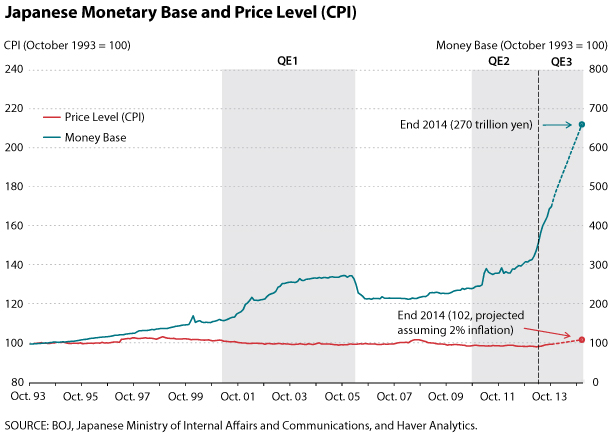Quantitative Easing in Japan: Past and Present
The Japanese consumer price index (CPI) in October 2013 was roughly the same as in October 1993. While Japan's CPI has had its ups and downs over the past 20 years, the average inflation rate has been roughly zero.
This uncommonly low inflation rate is viewed by some as harmful to economic performance. Shinzo Abe became prime minister of Japan in December 2012, promising (among other things) to end Japan's long experience with very low inflation. In accordance with this promise, the Bank of Japan (BOJ) recently adopted a 2 percent inflation target and embarked on a quantitative easing (QE) program designed to achieve this goal.
In a nutshell, QE entails unusually large purchases of assets by a central bank financed by money creation. The vast majority of asset purchases by the BOJ consist of Japanese government bonds. If a QE program is not reversed at some future date, then the government is effectively printing money (instead of raising taxes or cutting government expenditures) to pay its debt. This policy is sometimes described as "monetizing the debt," and it is widely believed to be inflationary.1
This is not Japan's first experiment with QE. An earlier program (QE1) began in March 2001. Within just two years, the BOJ increased its monetary base by roughly 60 percent. That program came to a sudden halt in March 2006 and was, in fact, mostly reversed. A second, relatively small QE program (QE2) was implemented in October 2010 and has gradually morphed into the recent more aggressive intervention (QE3) that began in April 2013. The first chart plots the time path of the monetary base over the period from October 1993 to October 2013 and its forecasted path through the end of 2014.

The first chart also plots the Japanese CPI over the same period. Strikingly, QE1 appears to have had little, if any, impact on inflation. Economic theory suggests that even large changes in the monetary base are not likely to have any inflationary consequences if people generally believe the program will be reversed at some future date.2 One interpretation of QE1 is exactly this. Essentially, the argument is that the BOJ was not really committed to increasing the inflation rate.3
Is there any reason to believe that Japan's latest QE program will have a different outcome? The first chart shows a noticeable uptick in the inflation rate since April 2013. But the evidence shows that the price level (CPI) can rise even in the absence of QE, so it's really too early to tell.
However, some evidence relating to inflation expectations suggests that this time could be different. As do the United States and other countries, the Japanese government issues inflation-indexed bonds—that is, bonds that pay an interest rate dependent on realized inflation. A measure of the bond market's forecast for future inflation can be constructed by comparing the yield on these inflation-indexed bonds with their non-indexed counterparts. The second chart plots this market-based measure of inflation expectations based on the data for bonds of different maturities.

As the second chart shows, inflation expectations in Japan appear to have been modestly positive for the period leading up to the 2008 financial crisis (core inflation in Japan over this period was roughly zero). There was a significant decline and recovery in inflation expectations during and after the 2008 financial crisis (the same pattern is evident in U.S. data). Interesting for Japan, however, is the fact that inflation expectations recently appear to have risen significantly above their historical average. This change suggests that the BOJ's 2 percent inflation target might be gaining credibility. More generally, it suggests that QE policies can have their desired effect on inflation if central banks are sufficiently committed to achieving their goal. Whether this will in fact eventually be the case in Japan remains to be seen.
Notes
1 See Andolfatto, David and Li, Li. "Is the Fed Monetizing the Debt?" Federal Reserve Bank of St. Louis Economic Synopses, 2013, No. 5, February 2, 2013; http://research.stlouisfed.org/publications/es/13/....
2 The inflationary force of money expansion is offset by the deflationary force of the expected future money contraction.
3 See Neely, Christopher J. "Political Pressure on the Bank of Japan: Interference or Accountability?" Federal Reserve Bank of St. Louis Economic Synopses, 2013, No. 7, March 1, 2013; http://research.stlouisfed.org/publications/es/13/....
© 2014, Federal Reserve Bank of St. Louis. The views expressed are those of the author(s) and do not necessarily reflect official positions of the Federal Reserve Bank of St. Louis or the Federal Reserve System.


 follow @stlouisfed
follow @stlouisfed